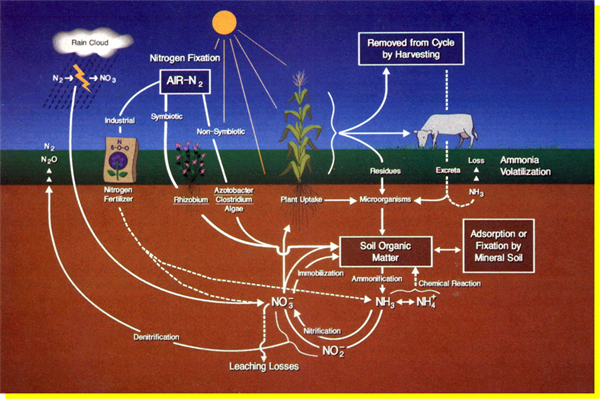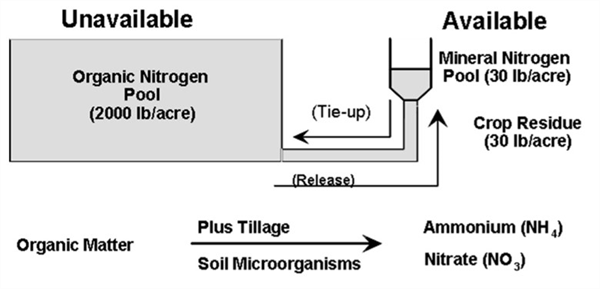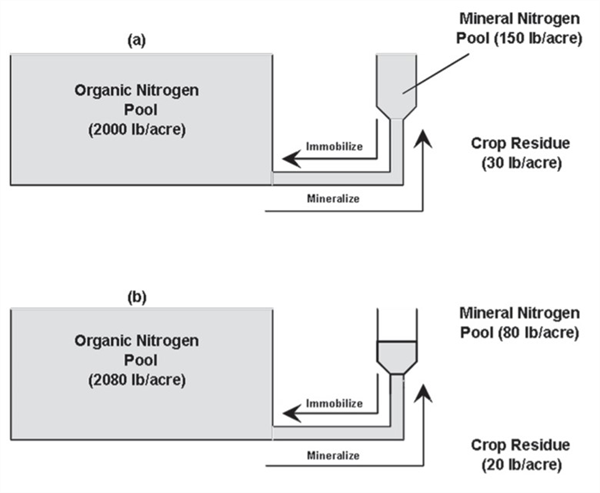
The cycling of nitrogen (N) in the soil is one of the most important aspects of soil health. Nitrogen cycling in the soil includes a multitude of interactions with microbes and plants.
The basics of soil N were described in a recent article posted in this UA Vegetable IPM newsletter (Silvertooth, 2024). The overall N reactions in the soil system are described in the N Cycle, Figure 1.

Figure 1. The nitrogen cycle.
Most of the N in soil is present as organic N in the soil organic matter. As a general estimate, there are approximately 1,000 pounds N per acre of this form for every one percent organic matter in the soil. However, soil organic matter (SOM) is relatively stable and resistant to further decay. So, most of the organic N in the soil is not biologically available during any given growing season (Havlin, et al. 2014;Thompson and Troeh, 2005; Warren, et al., 2017; and Weil and Brady, 2017).
Normally, about two percent of the N from SOM will be released each year to mineral forms when soil is cultivated. Arizona soils typically have approximately 1%organic matter. Thus, 10 to 20 pounds of N per acre is a typical amount of N present in unfertilized soils after cultivation and seed bed preparation.
We commonly assume that 1 acre-furrow slice of soil (soil that is 6 inches deep covering an area of 1 acre (43,560 ft.2))contains approximately 2 million pounds of soil. Thus, a soil in Arizona with 1% organic matter will have approximately 20,000 lbs. of SOM per acre and that will contain about1,000 lbs. of total N (5% N in the SOM), most of that being in an organic form that is not directly plant-available.
If 2% of the N in the SOM does mineralize in one year, that would release approximately 20 lbs. of N per acre per year. Accordingly, it is common to find 10 to 20 pounds of mineral plant-available N (NO3--N) per acre. That is a typical amount of mineral plant-available N present in unfertilized soils after cultivation and seed bed preparation. Higher levels of residual NO3--N is commonly a remnant of prior fertilizations.
Nitrogen Mineralization and Immobilization
Because N release from SOM is dependent upon decay by microorganisms, which themselves require N, the amount of N available for a crop is in constant flux. Unlike plants, which get their carbon (C) as carbon dioxide (CO2) from the air, many microorganisms get C from decaying organic matter.
Nitrogen availability depends upon the relative amount of C and N in the SOM, its resistance to decay, and the environmental conditions supporting microbial activity. Figure 2 illustrates how mineral N becomes more concentrated in SOM as soil organic matter decays.

Figure 2. The carbon to nitrogen ratio (C:N) declines and narrows as residues decay
until mineral nitrogen finally becomes available.
(Source: B. Raun In: Warren, et al., 2017)
Note that mineral N is not released during the first stages of decay. This is because N that is released is immediately consumed by active microorganisms. With time, remaining SOM becomes more resistant to decay, microorganisms die off, and there is more mineral N present than can be consumed by the few active microorganisms.
The first step of measurable mineral N release from SOM is usually in the form of ammonia NH3. The ammonia readily reacts with soil moisture to form ammonium NH4+. These two reactions can be stated simply as:
1) Organic nitrogen → NH3 (gas)
2) NH3 + H2O → NH4+ + OH- (ammonia + water → ammonium + hydroxide)
The process of converting or transforming N from organic compounds to inorganic compounds is called mineralization. This results in increasing N available for crops. The N form that is directly available to plants is nitrate-N (NO3--N).
When the reverse happens, plant-available N, primarily nitrate-N (NO3--N) is absorbed by crops or microorganisms. This process is called immobilization and results in a decrease in the amount of N in the soil solution that is immediately available for crops.
These processes of mineralization and immobilization and their interacting nature for a typical field soil situation are illustrated in Figure 3 starting with 2,060 lbs. of total soil N in this case partitioned among the SOM, crop residues, and mineral N pools.

Figure 3. Interacting pools of soil nitrogen.
(Source: B. Raun In: Warren et. al., 2017)
Approximately 98 percent of the soil N is unavailable for plant uptake. This large reservoir of organic N provides an important buffer against rapid changes in available N and plant stress. The small reservoir of mineral N can often be slowly replenished by mineralization (Figure 2.2).
Supplemental N as fertilizer usually must be added to support high, economic crop production levels when native levels of soil N mineralization are not sufficient. This is common in Arizona agricultural soils.
Example Case:
Immediately following fertilization with 120 pounds N, the system may be illustrated by Figure 4a. Note the increase of 120 pounds of N in the mineral N pool in addition to the original 60 lbs. of mineral N in this case (Figure 3), for a total of180 lbs. of mineral N. While the organic N pool is static at 2000 lb./acre in this example. In this case there is a total of 2,180 lbs. Nin the soil.
Addition of fertilizer N will stimulate microorganism activity, resulting in consumption of mineral N by soil microbes as they attack and break down some of the crop residues (immobilization) as illustrated in Figure 4b. Note that the total amount of N among the three pools (mineral, organic, and crop residues) is the same at 2,180lbs. N/acre.
The immobilized N will be present as microbial tissue and other new material in the organic pool. Note that the N present in the crop residue has dropped from 30 to 20 lbs. N/acre in this example due to microbial decomposition.
An important point to follow in this example is the transformations taking place with the consistent base of 2,180 lbs. of N partitioned into various forms. This is a rather simplified example, but it illustrates the natural dynamics taking place in the soil-plant system with the cycling of N and the challenges of managing N fertilizers effectively.

Figure 4. Relative amounts of organic and mineral nitrogen in soil immediately after
fertilizing (a) and several days after active immobilization (b).
As indicated by the two arrows pointing in opposite pathways, mineralization and immobilization are both taking place simultaneously. Immobilized fertilizer N will again become available in a few weeks if conditions favor crop uptake.
This exchange in N forms is often referred to as the mineralization-immobilization transformation (MIT) process and it is a core element of N cycling and management for crop production.
There is a constant flux taking place in soils among these pools of soil N through the MIT process and it is important to be aware of and understand this process when managing fertilizer N inputs for crop production.
References
Havlin, J.L., Beaton, J.D., Tisdale, S.L. and Nelson, W.L. 2014. Soil Fertility and Fertilizers; An Introduction to Nutrient Management. 6thEdition, Prentice Hall, Upper Saddle River, NJ.
Silvertooth, J.C. 2024. Soil Health – Nitrogen. University of Arizona Vegetable IPM Newsletter, Volume 15, No. 22,
Troeh, F.R. and Thompson, L.M. (2005) Soils and Soil Fertility. Sixth Edition, Blackwell, Ames, Iowa, 489.
Warren, J., H. Zhang, B. Arnall, J. Bushong, B. Raun, C. Penn, and J. Abit. 2017. Oklahoma Soil Fertility Handbook. Published Apr. 2017; Id: E-1039
Weil, R.R. and Brady, N.C. (2017) The Nature and Properties of Soils. 15thEdition, Pearson, New York.
Frost and freeze damage affect countless fruit and vegetable growers leading to yield losses and occasionally the loss of the entire crop. Frost damage occurs when the temperature briefly dips below freezing (32°F).With a frost, the water within plant tissue may or may not actually freeze, depending on other conditions. A frost becomes a freeze event when ice forms within and between the cell walls of plant tissue. When this occurs, water expands and can burst cell walls. Symptoms of frost damage on vegetables include brown or blackening of plant tissues, dropping of leaves and flowers, translucent limp leaves, and cracking of the fruit. Symptoms are usually vegetable specific and vary depending on the hardiness of the crop and lowest temperature reached. A lot of times frost injury is followed by secondary infection by bacteria or opportunist fungi confusing with plant disease.
Most susceptible to frost and freezing injury: Asparagus, snap beans, Cucumbers, eggplant, lemons, lettuce, limes, okra, peppers, sweet potato
Moderately susceptible to frost and freezing injury: Broccoli, Carrots, Cauliflower, Celery, Grapefruit, Grapes, Oranges, Parsley, Radish, Spinach, Squash
Least susceptible to frost and freezing injury: Brussels sprouts, Cabbage, Dates, Kale, Kohlrabi, Parsnips, Turnips, Beets
More information:
Interested in more information about mechanical weed control in vegetable crops? Check out this seminar given by Sam Hitchcock Tilton, Lakeshore Technical College. Topics covered include weed ecology, systems-based strategies for weed control, new and emerging machines on the market, individual tools and implements and best-use strategies for cultivating equipment. Although the target audience is small-scale vegetable growers, Sam gives many practical tips and insights that are applicable to large-scale vegetable farms. Even if you’re very knowledgeable about mechanical cultivation, this entertaining seminar is a good refresher on the basics of integrated weed management and one I think you’ll find interesting and informative.
Fig. 1. Sam Hitchcock Tilton presenting seminar entitled “Mechanical Weed
Control and Weed Ecology in Vegetable Production”. Click the video above to view a recording of the presentation. (Photo credits: Practical Farmers of Iowa,
Ames, IA).
Boerhavia coulteri is a flowering plant that belongs to the Nyctaginaceae or Four O'clock family known by the common name Coulter's spiderling. Its native to the desert areas of the SW in the US and North of Mexico. It is a summer annual or perennial weed producing an erect or creeping stem up to 0.7-0.8 m in length. Grows in disturbed areas, ditch banks, and roadsides.

The cotyledons are oblong,1.0-2.5 cm.
Plants are slightly pubescent with sticky resin glands toward the bases. The leaves are lance-shaped, somewhat triangular, pointed, sometimes wavy or rippled along the edges, and 5 centimeters in maximum length1.
We have this weed in our Yuma County AZ and very abundantly in the sandy soils of the Yuma Mesa.
I added a table from a weed control experiment conduced for Boheravia erecta.
The Research Paper called :” The effect of herbicide tank mix on the weed species diversity
in sugarcane (Saccharum officinarum)” mentions: “All the herbicide mixes significantly controlled Boheravia with Pendimethalin. Being Pendimethalin plus Atrazine the best treatment as shown in the table below.
Resistant varieties are crucial for effective insect pest management, more specifically in organic crop production. When growing crops organically, resistant varieties should be the first line of defense against insect pests. Compared to nonresistant varieties, insect-resistant crop varieties are less vulnerable to insect attacks or yield well despite insect attacks.
Resistance in crops can be expressed through different mechanisms, including antibiosis, antixenosis, and tolerance. For the antibiosis mechanism, the resistant crops act on the life history traits of the pest, such as affecting fecundity, growth, development, and survival. Thus, this reduces the pest population. On the other hand, antixenosis is characterized by the ability of the crop to affect the behavior of the pest by deterring it after initial tasting or probing, which is non-preference. For the tolerance mechanism, however, the crops can sustain a high density of pests and still maintain their yield potential. In most cases, the overall resistance of a variety is a combination of all these three mechanisms.
There is also a type of resistance called phenological resistance, field resistance, or pseudo-resistance, which is when the crop appears to be resistant because it is at a less susceptible stage when a pest attack occurs. This may happen either because of the rate of development of the crop or due to management practices implemented, causing the crop to escape the pest pressure. Thus, the implementation of proper agronomic practices plays a significant role in improving the ability of crops to resist pest attacks.
In certain scenarios, additional insect control measures such as the use of bioinsecticides (in organic production) and natural enemies may be necessary in conjunction with an insect-resistant variety for comprehensive pest control. However, even in cases where additional control measures are required, the cultivation of a resistant variety can significantly delay and reduce the amount of insecticide applications needed. This underscores the economic, ecological, and environmental benefits of using insect-resistant crop varieties.
Previous studies conducted at Yuma Agricultural Center demonstrated that resistant lettuce varieties can provide suitable control of aphids affecting lettuce in the region. Therefore, it is very important to consider cultivating insect-resistant lettuce varieties for suitable management of aphids in organic lettuce production since biological insecticide options are currently limited. My lab is planning to evaluate several lettuce varieties to determine lettuce varieties that carry resistance against aphids in an attempt to generate applicable information on varieties that could fit well within the production practices and environmental conditions of Arizona’s vegetable-growing regions.
Results of pheromone and sticky trap catches can be viewed here.
Corn earworm: CEW moth counts remain at low levels in all areas, well below average for this time of year.
Beet armyworm: Trap increased areawide; above average compared to previous years.
Cabbage looper: Cabbage looper counts decreased in all areas; below average for this time of season.
Diamondback moth: DBM moth counts decreased in most areas. About average for this time of the year.
Whitefly: Adult movement beginning at low levels, average for early spring.
Thrips: Thrips adult counts reached their peak for the season. Above average compared with previous years.
Aphids: Aphid movement decreased in all areas; below average for late-March.
Leafminers: Adults remain low in most locations, below average for March.